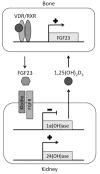Vitamin D: metabolism
- PMID: 20511049
- PMCID: PMC2879391
- DOI: 10.1016/j.ecl.2010.02.002
Vitamin D: metabolism
Abstract
The biologically active metabolite of vitamin D, 1,25(OH)(2)D(3), affects mineral homeostasis and has numerous other diverse physiologic functions including effects on growth of cancer cells and protection against certain immune disorders. This article reviews the role of vitamin D hydroxylases in providing a tightly regulated supply of 1,25(OH)(2)D(3). The role of extrarenal 1alpha(OH)ase in placenta and macrophages is also discussed, as well as regulation of vitamin D hydroxylases in aging and chronic kidney disease. Understanding specific factors involved in regulating the hydroxylases may lead to the design of drugs that can selectively modulate the hydroxylases. The ability to alter levels of these enzymes would have therapeutic potential for the treatment of various diseases, including bone loss disorders and certain immune diseases.
Copyright 2010 Elsevier Inc. All rights reserved.
Figures


Republished in
-
Vitamin D: metabolism.Rheum Dis Clin North Am. 2012 Feb;38(1):1-11, vii. doi: 10.1016/j.rdc.2012.03.003. Rheum Dis Clin North Am. 2012. PMID: 22525839
References
-
- Webb AR, Kline L, Holick MF. Influence of season and latitude on the cutaneous synthesis of vitamin D3: exposure to winter sunlight in Boston and Edmonton will not promote vitamin D3 synthesis in human skin. J Clin Endocrinol Metab. 1988;67:373–8. - PubMed
-
- Matsuoka LY, Ide L, Wortsman J, et al. Sunscreens suppress cutaneous vitamin D3 synthesis. J Clin Endocrinol Metab. 1987;64:1165–8. - PubMed
-
- Matsuoka LY, Wortsman J, Dannenberg MJ, et al. Clothing prevents ultraviolet-B radiation-dependent photosynthesis of vitamin D3. J Clin Endocrinol Metab. 1992;75:1099–103. - PubMed
-
- Prosser DE, Jones G. Enzymes involved in the activation and inactivation of vitamin D. Trends Biochem Sci. 2004;29:664–73. - PubMed
-
- Omdahl JL, Morris HA, May BK. Hydroxylase enzymes of the vitamin D pathway: expression, function, and regulation. Annu Rev Nutr. 2002;22:139–66. - PubMed
Publication types
MeSH terms
Substances
Grants and funding
LinkOut - more resources
Full Text Sources
Other Literature Sources
Medical

